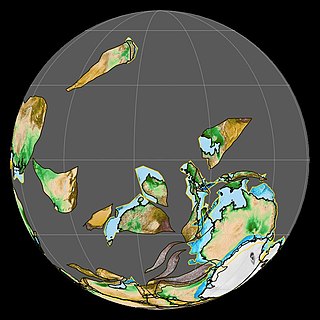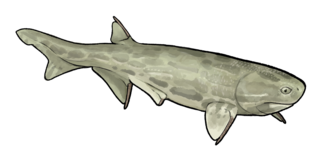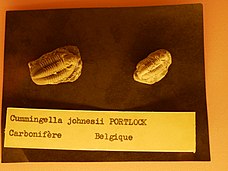
The Carboniferous is a geologic period and system of the Paleozoic era that spans 60 million years from the end of the Devonian Period 358.9 Ma to the beginning of the Permian Period, 298.9 Ma. It is the fifth and penultimate period of the Paleozoic era and the fifth period of the Phanerozoic eon. In North America, the Carboniferous is often treated as two separate geological periods, the earlier Mississippian and the later Pennsylvanian.

The Tournaisian is in the ICS geologic timescale the lowest stage or oldest age of the Mississippian, the oldest subsystem of the Carboniferous. The Tournaisian age lasted from 358.9 Ma to 346.7 Ma. It is preceded by the Famennian and is followed by the Viséan. In global stratigraphy, the Tournaisian contains two substages: the Hastarian and Ivorian. These two substages were originally designated as European regional stages.

Stethacanthus is an extinct genus of shark-like cartilaginous fish which lived from the Late Devonian to Late Carboniferous epoch, dying out around 298.9 million years ago. Fossils have been found in Australia, Asia, Europe and North America.

Arthropleura is a genus of massive millipedes that lived in what is now North America and Europe around 345 to 290 million years ago, from the Viséan stage of the lower Carboniferous Period to the Sakmarian stage of the lower Permian Period. The species of the genus are the largest known land invertebrates of all time, and would have had few, if any, predators.

Acanthodes is an extinct genus of acanthodian fish. Species have been found in Europe, North America, and Asia, spanning the Early Carboniferous to the Early Permian, making it one of the youngest known acanthodian genera.

The Hangenberg event, also known as the Hangenberg crisis or end-Devonian extinction, is a mass extinction that occurred at the end of the Famennian stage, the last stage in the Devonian Period. It is usually considered the second-largest extinction in the Devonian Period, having occurred approximately 13 million years after the Late Devonian mass extinction at the Frasnian-Famennian boundary. The event is named after the Hangenberg Shale, which is part of a sequence that straddles the Devonian-Carboniferous boundary in the Rhenish Massif of Germany.
This list of fossil arthropods described in 2013 is a list of new taxa of trilobites, fossil insects, crustaceans, arachnids and other fossil arthropods of every kind that have been described during the year 2013. The list only includes taxa at the level of genus or species.

Paleontology or palaeontology is the study of prehistoric life forms on Earth through the examination of plant and animal fossils. This includes the study of body fossils, tracks (ichnites), burrows, cast-off parts, fossilised feces (coprolites), palynomorphs and chemical residues. Because humans have encountered fossils for millennia, paleontology has a long history both before and after becoming formalized as a science. This article records significant discoveries and events related to paleontology that occurred or were published in the year 2014.
This list of fossil arthropods described in 2014 is a list of new taxa of trilobites, fossil insects, crustaceans, arachnids and other fossil arthropods of every kind that have been described during the year 2014. The list only includes taxa at the level of genus or species.

The Eyam Limestone is a geologic formation in the Peak District, England. It preserves fossils dating back to the Viséan stage of the Carboniferous period, and represents a marine environment.

Hunts Bay Oolite is an oolitic Carboniferous limestone geological formation found in the south Wales region. It is named after Hunts Bay on the Gower peninsula, south-south west of Bishopston, where a significant amount of the limestone forms the cliffs there.

The Ballagan Formation is a geologic formation in Scotland and England. It preserves fossils dating back to the early part of the Carboniferous period. Its name comes from the "Ballagan Beds" of Ballagan Glen, near Strathblane, which has a good example of this geological formation.

The Corona Formation is a geologic formation of the Carnian Alps at the border of Austria and Italy. It preserves fossils dated to the Gzhelian stage of the Late Carboniferous period.
This list, 2015 in molluscan paleontology, is a list of new taxa of ammonites and other fossil cephalopods, as well as fossil gastropods, bivalves and other molluscs that have been described during the year 2015.
This list of fossil arthropods described in 2010 is a list of new taxa of trilobites, fossil insects, crustaceans, arachnids and other fossil arthropods of every kind that have been described during the year 2010. The list only includes taxa at the level of genus or species.
This list of fossil arthropods described in 2018 is a list of new taxa of trilobites, fossil insects, crustaceans, arachnids, and other fossil arthropods of every kind that were described during the year 2018, as well as other significant discoveries, and events related to arthropod paleontology that are scheduled to occur in the year 2018.
The Holkerian is a sub-stage of the Viséan stage of the International Commission on Stratigraphy (ICS) geological timescale. It is one of five sub-stages commonly used in the Viséan stage within stratigraphy by British, Irish and other geologists outside the US and Asia.
This list of fossil arthropods described in 2019 is a list of new taxa of trilobites, fossil insects, crustaceans, arachnids and other fossil arthropods of every kind that are scheduled to be described during the year 2019, as well as other significant discoveries and events related to arthropod paleontology that are scheduled to occur in the year 2019.
2021 in arthropod paleontology is a list of new arthropod fossil taxa, including arachnids, crustaceans, insects, trilobites, and other arthropods that were announced or described, as well as other significant arthropod paleontological discoveries and events which occurred in 2021.

Daidal is an extinct genus of mantis shrimp that lived during the Carboniferous period. It is the only genus in the family Daidalidae. Three species are currently placed within the genus. Fossils of the type species, D. acanthocercus, have been found in the Bear Gulch Limestone of Montana. A second species, D. pattoni, is known from the Lower Limestone Formation of Scotland, and the third species, D. schoellmanni, was discovered in Westphalia, Germany. The genus has been proposed to be polyphyletic, with D. pattoni possibly being an earlier diverging lineage, though more specimens and research are needed to confirm this.














